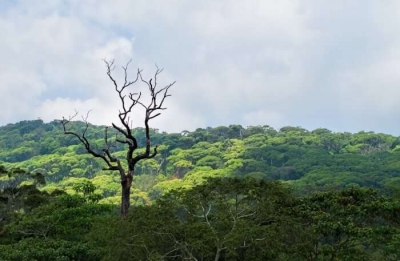
Situated in the south-western part of the Asian country Sri Lanka, the Sinharaja Forest Reserve covers an area of more than 88 sq.km. The region is considered the country’s “last viable area of primary tropical rainforest”. Marked by undulating terrain, the area is interspersed with valleys, ridges, and streams. A fertile region with more than 220 species of trees and woody climbers, it has at least 16 species of trees that are rare. More than 30 mammal species, 140 bird species, 20 amphibian species, and 70 reptiles species can be found in the Reserve. It is most noted for its endemism (see box) in mammals, birds, amphibians, reptiles, and fish. Endemism is said to be particularly high in butterfly species. Among the threatened, endangered, and rare species in the Reserve are the Sri Lanka wood pigeon, the greenbilled coucal, the Sri Lanka white-headed starling, the Sri Lanka blue magpie, and the Sri Lanka broad-billed roller. The Reserve, declared a UNESCO World Heritage site in 1988, is a large area surrounded by forests that form a natural protective boundary. However, it is not without its threats such as encroachments and development activity.
Wildlife
Spurfowl, junglefowl, pigeons, doves, frogmouths, swifts, coucals, koels, malkohas, waterhen, egrets, owls, buzzards, eagles, kites, trogons, hornbills, bee-eaters, kingfishers, barbets, woodpeckers, parrots, parakeets, pittas, orioles, minivets, swallows drongos, shrikes, magpies, crows, tailorbirds, bulbuls, warblers, babblers, nuthatches, thrushes, mynas, flycatchers, flowerpeckers, sunbirds, and munias are among the birds that can be seen in the region. Among the animals and reptiles found here are leopards, langurs, macaques, jackals, wild cats, boars, sambar, barking deer, mouse deer, otters, pangolins, pythons, forest lizards, and frogs.
What is endemism?
- If any species is spread across only one specific region, it is said to be endemic to the region.
- It could be a small or large area. For instance, a country or even a continent. But the species is not found outside of this region in the wild.
- Usually, plants and animals become endemic to a region in two ways. One way is by evolving in and adapting to a specific environment and continuing to live only there. Sometimes this happens in remote locations. For instance, finches in the far off Galapagos Islands. Another way is when a species loses most of its original range over the years and remains confined to a small region.
- Some of the species endemic to India are the Asiatic lion, sangai deer, Nilgiri tahr, and Malabar civet.
Purple-faced langur facts
- One of the endemic mammals found in Sinharaja Forest Reserve is the purple faced langur. It is also an endangered species, mainly because of habitat loss due to deforestation.
- It has a few sub-species, including the western purple-faced langur. The face of this long-tailed arboreal monkey is actually greyish-black, as opposed to purple as its name suggests.
- It is a folivore, meaning it feeds on leaves. It is said to prefer young leaves for their high protein content. The langur is also known to eat fruit, flowers and seeds.
- Though the langurs habitat changes with the sub-species, it often seems to inhabit areas near permanent water sources.
- It requires a nice canopy cover, but there are very few such forests in the country now, and none of them inside protected areas.
Picture Credit : Google
Leave a Reply